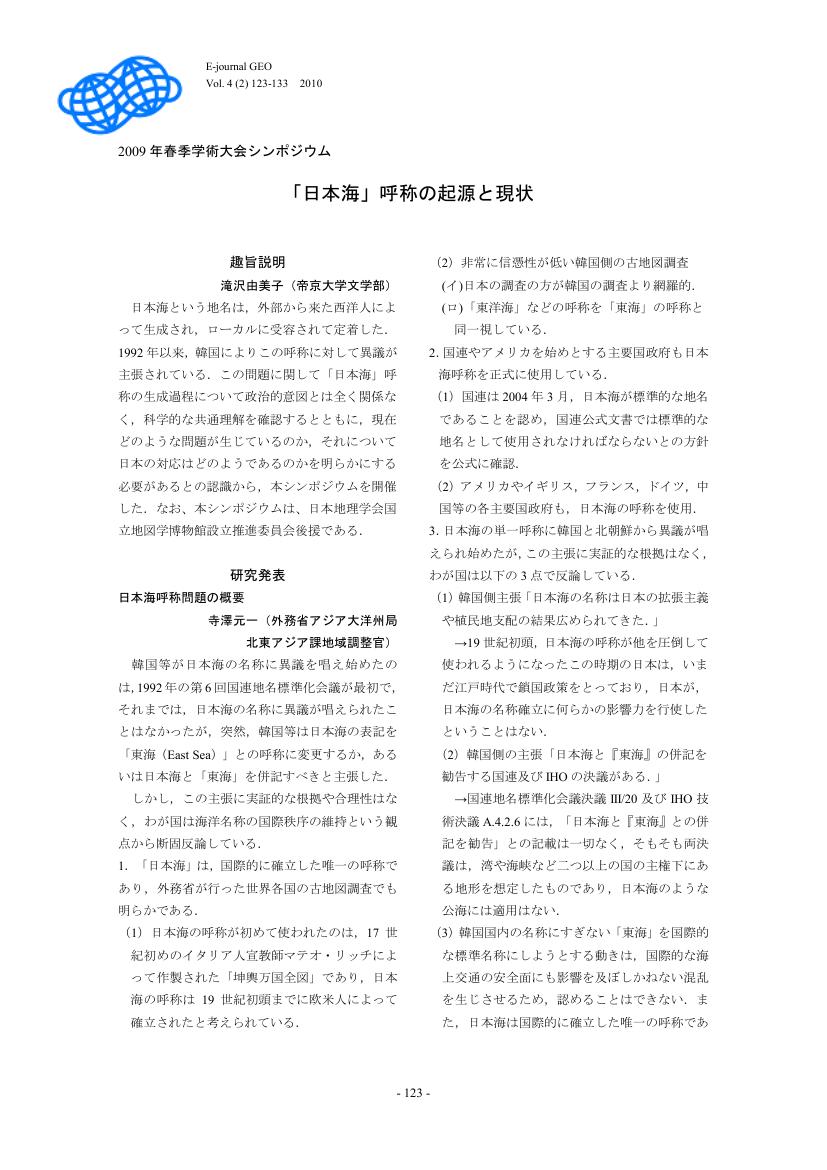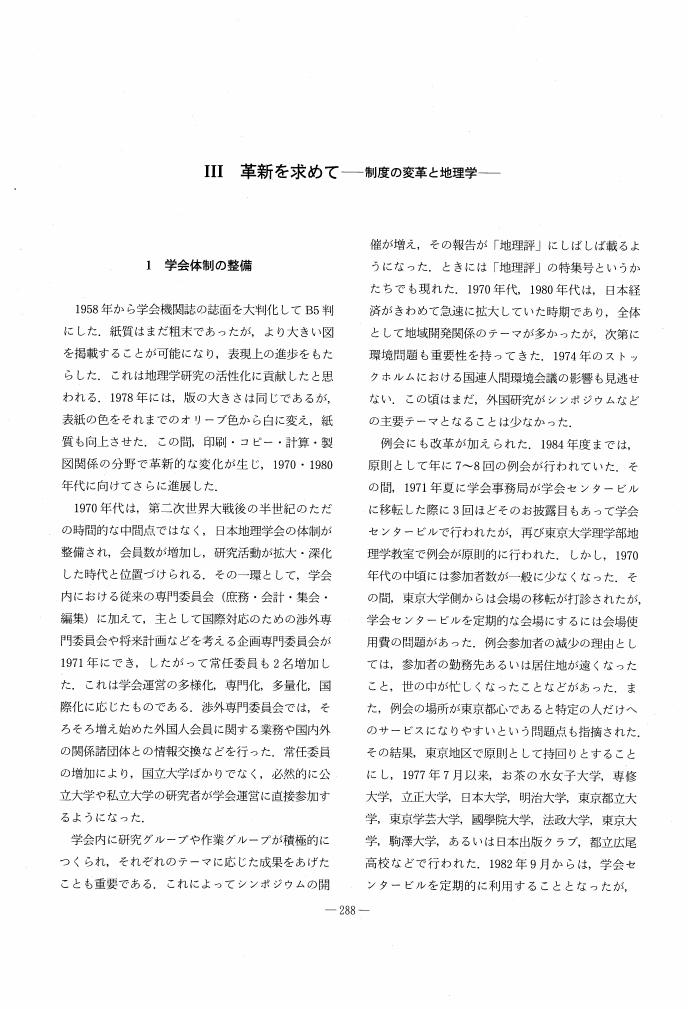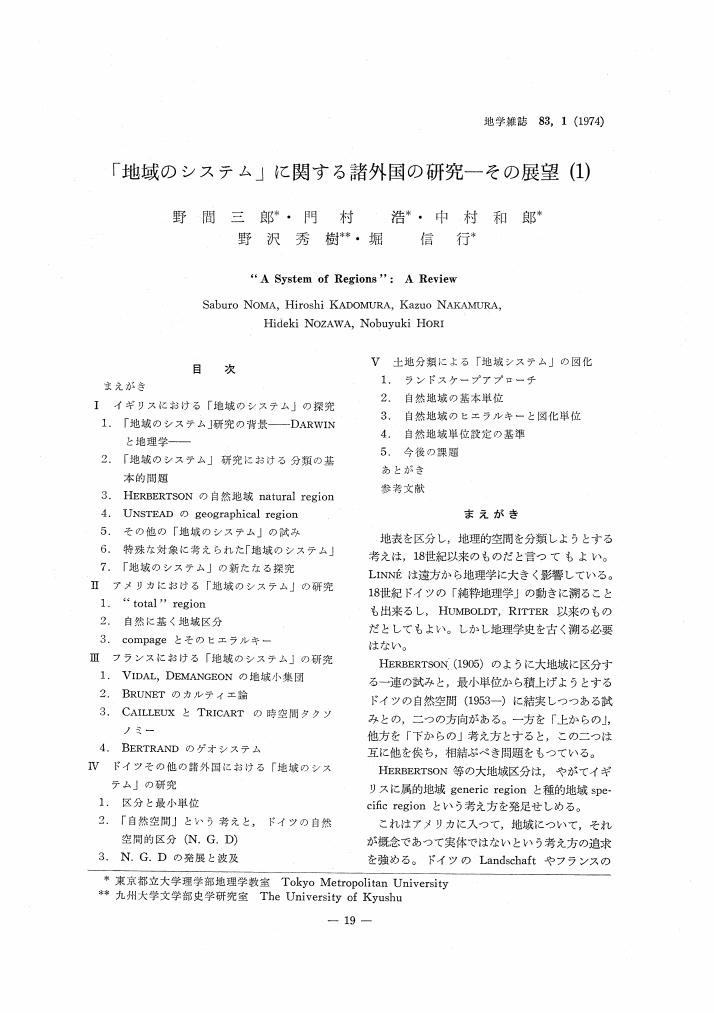15 0 0 0 OA II 戦後復興と地理学の展開
9 0 0 0 OA 「日本海」呼称の起源と現状
- 著者
- 滝沢 由美子 寺澤 元一 伊藤 友孝 磯部 民夫 谷治 正孝 渡辺 浩平 KOMEDCHIKOV Nikolay N. 青山 宏夫 中村 和郎 田邉 裕
- 出版者
- 公益社団法人 日本地理学会
- 雑誌
- E-journal GEO (ISSN:18808107)
- 巻号頁・発行日
- vol.4, no.2, pp.123-133, 2010 (Released:2010-04-06)
- 被引用文献数
- 1
8 0 0 0 OA III 革新を求めて-制度の変革と地理学-
- 著者
- 正井 泰夫 吉野 正敏 谷内 達 中村 和郎 米倉 伸之 戸所 隆 小池 一之 斉藤 功
- 出版者
- 公益社団法人 日本地理学会
- 雑誌
- 地理学評論 Ser. A (ISSN:00167444)
- 巻号頁・発行日
- vol.73, no.4, pp.288-304, 2000-04-01 (Released:2008-12-25)
8 0 0 0 OA IV 日本の現代地理学の回復と展望
2 0 0 0 OA グレートプレーンズにおける干ばつのパーセプション
- 著者
- サーリネン T.F. 中村 和郎
- 出版者
- 空間の理論研究会
- 雑誌
- 理論地理学ノート (ISSN:09120459)
- 巻号頁・発行日
- vol.3, pp.4-13, 1983-03
1 0 0 0 OA 地理学と主題図
- 著者
- 中村 和郎
- 出版者
- 公益社団法人 日本地理学会
- 雑誌
- 地理学評論 Ser. A (ISSN:00167444)
- 巻号頁・発行日
- vol.71, no.3, pp.155-168, 1998-03-01 (Released:2008-12-25)
- 参考文献数
- 31
- 被引用文献数
- 1
In striking contrast to the long history of general maps, it was not until the latter half of the seventeenth century that thematic maps appeared. A. Hettner, (1927), who fully discussed the unique properties and importance of maps in geography, did not yet use the term “thematic maps, ” but stated instead that new types of maps had been introduced in the nineteenth century. A. Kircher (1665) and E. W. Happel (1685) were among the first thematic map makers. The contribution of E. Halley deserves special mention. His world map of trade winds and monsoons (1686) was the first map which used iconic symbols to depict wind directions, and even the seasonal reversal of the Indian monsoon was well demonstrated. Very few had ever used isolines before Halley, who made a chart of compass variations in 1701. Thematic maps made rapid progress in the eighteenth century, when maps of geology, biology, linguistics, population density, economics, administrative divisions, etc. were made. In the author's opinion, Alexander von Humboldt and Karl Ritter made full use of thematic maps to establish the firm foundation of modern geography. “Sechs Karten von Europa” by Ritter, attached to his book “Regional Geography of Europe, ” was the first printed atlas of thematic maps. An incredible amount of information concerning individual locations on the earth's surface was put into an orderly system of knowledge in the form of thematic maps. By making distribution maps of trees and shrubs and of cultivated plants, he delineated several natural regions which were almost parallel to the latitudinal zones. His famous definition of geography, that is, geography deals with the earth's surface as long as it is earthly filled (irdisch erfüllt), can be well understood through his intention to make various thematic maps, because comparable information must be collected for the whole region to complete a map. Halley's isoline map was followed only by those of Ph. Buache (1752) and J. I. Dupain-Triell (1791) until Humboldt made an isothermal chart in 1817. The isoline map is unique in that it can be made with a limited number of data. Humboldt used only 58 cities to produce his chart of a wide area in the Northern Hemisphere. In addition, isoline maps are also unique in that, once made, interpolation and extrapolation allow determination of the figure for every arbitrary point. With the aid of Humboldt, H. Berghaus, the eminent cartographer, published the “Physische Atlas” which included many thematic maps. It cannot be denied that Humboldt was also very keen to illustrate the regularities of physical phenomena and the interrelationships between them using thematic maps.Scrutiny of the history of modern geography from the viewpoint of thematic maps, discovering what type of map was developed for what purpose, etc., is a promising research area.For example, C. Darwin made a distribution map of coral reefs to test his subsidence theory explaining the formation of three types of coral reef. Emphasizing the shapes that maps can describe better than language, O. Peschel believed that a precisely prepared map could illustrate the hidden factors explaining the formation of fjords and other phenomena. F. Ratzel also recognized the importance of map representation in the science of “Anthropogeographie.” His movement theory was highly appreciated by the Kulturkreis school in cultural anthropology. L. Frobenius developed the culture-complex diffusion theory with the help of a number of thematic maps.K. Yanagita (1930), a Japanese folklorist, assembled more than three hundred parochial expressions for the word “snail” into a map. Identifying a concentric pattern with the center in Kyoto from a seemingly chaotic map, he concluded that the distribution pattern of some Japanese dialects resulted from a slow diffusion from the ancient cultural core.
1 0 0 0 OA 「地域のシステム」に関する諸外国の研究-その展望 (2)
- 著者
- 野間 三郎 門村 浩 中村 和郎 野沢 秀樹 堀 信行
- 出版者
- Tokyo Geographical Society
- 雑誌
- 地学雑誌 (ISSN:0022135X)
- 巻号頁・発行日
- vol.83, no.2, pp.103-124, 1974-04-25 (Released:2010-02-25)
- 参考文献数
- 157
1 0 0 0 OA 「地域のシステム」に関する諸外国の研究-その展望 (1)
- 著者
- 野間 三郎 門村 浩 中村 和郎 野沢 秀樹 堀 信行
- 出版者
- Tokyo Geographical Society
- 雑誌
- 地学雑誌 (ISSN:0022135X)
- 巻号頁・発行日
- vol.83, no.1, pp.19-37, 1974-02-25 (Released:2009-11-12)
- 被引用文献数
- 1
1 0 0 0 OA 鈴木秀夫先生のご逝去を悼む
- 著者
- 中村 和郎
- 出版者
- 公益社団法人 日本地理学会
- 雑誌
- 地理学評論 Series A (ISSN:18834388)
- 巻号頁・発行日
- vol.84, no.6, pp.631-632, 2011-11-01 (Released:2016-09-29)
1 0 0 0 OA 三浦半島-世田谷に延びる積雲列「横横雲」
- 著者
- 中村 洋介 中村 和郎
- 出版者
- The Association of Japanese Geographers
- 雑誌
- 日本地理学会発表要旨集
- 巻号頁・発行日
- pp.128, 2006 (Released:2006-05-18)
1.はじめに 本発表では、一本の積雲列がしばしば三浦半島から東京・世田谷方向に延びていることを発見したので報告する。関東南部の積雲列は東京環状八号線(通称「環八」)上にできる低層の積雲列「環八雲」が知られる。塚本(1990)は、夏季に形成される環八上空の積雲列を「ヒートアイランド雲」と名づけ、環八付近の高温域に東京湾と相模湾からの海風が収束し、大気汚染物質が凝結核になることで形成されると報告した。本報告での積雲列は、三浦半島の中央を南北に延びる横浜横須賀道路(通称「横横」)に沿って出現する。比較的交通量の多い横浜横須賀道路上空に一列の積雲が連なることからこの雲を仮に「横横雲」と名付けた。本発表では、「横横雲」の出現日、出現時の風向、気温、海水温、気圧配置と現段階で考察される出現の成因について報告する。分析には気象庁アメダス、神奈川県環境科学センター、神奈川県農林水産情報センター、神奈川県水産技術センターの資料を使用した。2.「横横雲」の出現 「横横雲」は低層の複数の積雲がほぼ南北方向に長く一列に並ぶ雲列である。2005年は年間20回程度の発生を確認した。観測は横浜市戸塚区小雀町の丘陵上からの目視である。積雲列を追跡すると、日平均通行台数13万台の横浜横須賀道路上空に発生していた。発生時期は3_から_9月に多くみられ、発生時の多くは移動性高気圧や太平洋高気圧に関東地方が覆われている。「横横雲」は早朝から夕方にかけて発生し、夜間は消滅する。発生時、積雲の各セルは北方向へ流れている。発生時の風向は、三浦半島の東京湾側では南東成分の風向、相模湾側では南西成分の風向を示す(図1)。冬季の北成分の風向時は発生しない。 「横横雲」発生時の2005年4月24日に積雲列を北方向に追跡すると、横浜横須賀道路から第三京浜上空に延び、川崎IC付近で世田谷(環八)方向に続いていた。一方で2005年8月4日に南方向に追跡すると逗子付近で雲が形成されていることを確認した。3.「横横雲」の成因 三浦半島のほぼ中央を南北に積雲列が並び、発生時には積雲列に向かって風が収束している。暖められた三浦半島の陸域と周りを囲む比較的低い海水温域による海風の発生が東京湾と相模湾からの風の収束を生み、「横横雲」が発生していると推察される。発生には横浜横須賀道路の交通量の関わりも考えられるが、より交通量の多い横浜新道上空には発生していないなど明瞭な交通量との因果関係は特定できなかった。4.おわりに 甲斐ほか(1995)や糸賀ほか(1998)では、「環八雲」は太平洋高気圧か移動性高気圧に覆われる南風成分の日に出現し、海風の収束とヒートアイランドによる上昇気流が成因であると報告している。「横横雲」の成因もこれらの報告と類似している点もあると推察されるが、これまでの「環八雲」の報告では東京都内のみの分析であり、本調査で「環八雲」は「横横雲」として神奈川県東部にも延びている可能性があることが分かった。中西・菅谷(2004)は、暖候期において相模湾・東京湾・鹿島灘からの海風が収束してつくられる東京湾周辺の雲列下で午後に降水がみられることを報告している。2005年7月25日には、「横横雲」出現後の17時に三浦半島から栃木県小山にかけてのレインバンドがみられた。今後は「横横雲」と降雨の関連についても検討してゆきたい。参考文献糸賀ほか 1998.環八雲が発生した日の気候学的特徴_-_1989_から_1993年8月の統計解析_-_.天気45:13‐22.甲斐ほか 1995.東京環状八号線道路付近の上空に発生する雲(環八雲)の事例解析_-_1989年8月21日の例_-_.天気42:11‐21.塚本1990.ヒートアイランド現象と雲_-_1989年夏の観測から_-_.気象34:8‐11.中西・菅谷2004.夏季の東京湾周辺に発生する雲列と局地気象および午後の降水との関係.天気52:729-73
1 0 0 0 OA 抗マラリア薬の開発を目指した構造生物学的研究
- 著者
- 田中 信忠 梅田 知伸 日下部 吉男 中西 雅之 北出 幸夫 中村 和郎
- 出版者
- 公益社団法人 日本薬学会
- 雑誌
- YAKUGAKU ZASSHI (ISSN:00316903)
- 巻号頁・発行日
- vol.133, no.5, pp.527-537, 2013 (Released:2013-05-01)
- 参考文献数
- 30
- 被引用文献数
- 4 4
The human malaria parasite Plasmodium falciparum is responsible for the death of more than a million people each year. The emergence of strains of this malaria parasite resistant to conventional drug therapy has stimulated the search for antimalarial compounds with novel modes of action. Here the structure-function relationship studies for two Plasmodium proteins are presented. One example is the structural studies for S-adenosyl-L-homocysteine hydrolase from Plasmodium falciparum (PfSAHH) and the other example is those for 1-deoxy-D-xylulose reductoisomerase from Plasmodium falciparum (PfDXR). In the former study, the clue for design of species specific PfSAHH inhibitors was obtained by the structural comparison of the active site of PfSAHH with that of human SAHH (HsSAHH). Our study revealed that the inhibitor selectivity depends on the difference of only one amino acid residue in the active site; Cys59 in PfSAHH vs. Thr60 in HsSAHH. In the latter study, the inhibition of PfDXR enzyme by fosmidomycin has proved to be efficient in the treatment of uncomplicated malaria in recent clinical trials conducted in Gabon and Thailand. Our crystal structure analyses of PfDXR/inhibitor complexes revealed the molecular basis of fosmidomycin's action in P. falciparum. We expect that the structure-function relationship studies on Plasmodium proteins are useful for developing the more effective antimalarial compounds.






